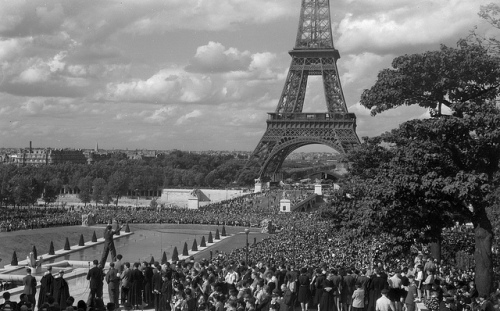Following on from our blog last week about the D-Day Landings, we thought you might interested in these snippets about the actual liberation of Paris itself.
The fight for Paris’ freedom from Nazi occupation took place between August 19th and 25th 1944. What began with the French resistance, and led to reinforcements from General Charles de Gaulle’s Free French Forces and the US Third Army, commanded by General George S. Patton on August 24th, ended with the surrender of the German garrison, thus ending four years of Nazi occupation in the City of Light.
Here are eight facts about the Battle for Paris which you may not have been taught about in history classes:
StrikesÂ
Métro and railway staff went on strike on August 10. On the 12th, postal workers and policemen followed suit. By the 18th, it had become a general strike, with fighting breaking out across the city. On August 19th, 3000 striking policemen invaded and liberated the Prefecture de Police.
Barricades
Taking a leaf from French Revolutionary tactics, the Resistance and other Parisians built over 600 barricades around Paris in order to defend themselves against the German garrison… but the poorest areas of Paris were excluded from this protection.
Métro Hospital
Due to a shortage of medical facilities, and heavy casualties, The Red Cross set up a makeshift hospital in the Métro Bastille station.
Controversy
General Dietrich Von Choltitz, the German commander newly in charge of governing Paris, claimed that he disobeyed direct orders from Hitler to destroy the city’s monuments and bridges, citing his belief that the Führer had gone insane. He also claimed to have negotiated with the Resistance, before surrendering himself and the 17,000 German troops to General Jacques-Philippe Leclerc and Henri Rol-Tanguy on August 25th.
Given that Von Choltitz had ordered the execution of 35 resistance members on August 16th, the destruction of the windmills at Pantin on August 19th, and the burning of the Grand Palais on August 23rd, his story seems unlikely.
Racism
In 2009, it was revealed that General de Gaulle’s not unreasonable desire to have the triumphant troops led into Paris by a wholly French armored division was met with a condition laid down by the Allied High Command, that only white soldiers were to be allowed. Although unlike the Americans, the British did not racially segregate their soldiers, they nevertheless supported this American condition, made by Eisenhower’s Chief of Staff, Major General Walter Bedell Smith. Since 65% of the Free French Forces was made up of black troops, de Gaulle replaced them with Spanish soldiers in order to meet the Allies’ demands.
Snipers
The day after the German surrender, General de Gaulle, held a triumphal Liberation Day parade through Paris. As he reached Place de Concorde, German snipers in the Hôtel de Crillon shot into the crowd. Fortunately, no one was killed; unfortunately however, the snipers were able to escape.
Continued Fighting
Across Paris, for two more days after the Liberation, there were small pockets of fighting and clashes with rogue German soldiers who had not surrendered with the rest of their troops.
Purification
20,000 women had their hair shaved off and were paraded through the streets of Paris in order to shame them for having relationships with German soldiers. In addition, women who had collaborated, voluntarily or not, with the enemy were condemned to death.
